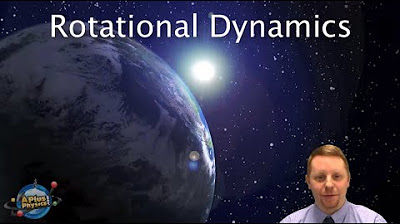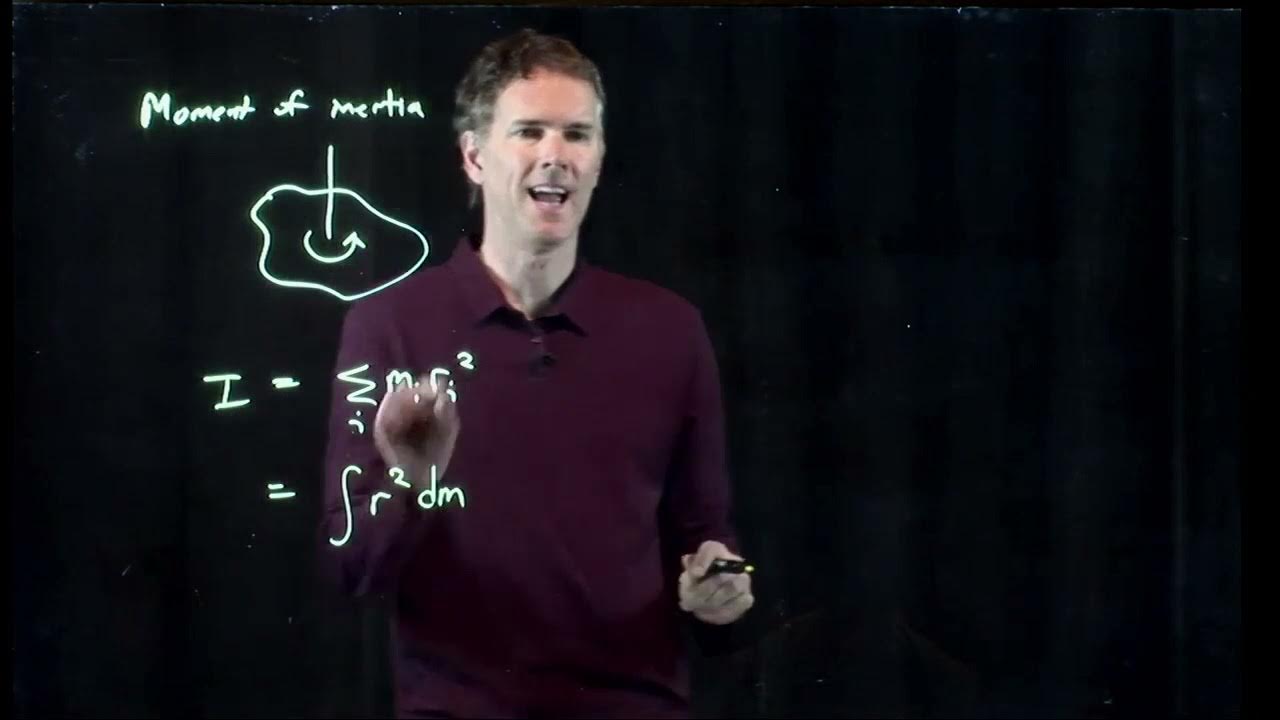Demonstrating Rotational Inertia (or Moment of Inertia)
TLDRIn this educational video, the concept of rotational inertia, also known as the moment of inertia, is explored using a "Rotational Inertia Demonstrator" from Arbor Scientific. The setup includes three differently sized pulleys on a frictionless axle with adjustable masses and spokes. The video explains that the moment of inertia is the sum of the product of each particle's mass and the square of its distance from the axis of rotation. By adjusting the masses' positions, the effect on the system's rotational inertia and subsequent angular acceleration is demonstrated. The importance of considering the net torque, not just individual torques, is emphasized. The video concludes by showing that adding mass to the pulley in the opposite direction results in the same magnitude of angular acceleration but in the opposite direction, reinforcing the principle that it is the net torque that dictates the system's rotational dynamics.
Takeaways
- 📐 **Moment of Inertia**: The moment of inertia for a system of particles is the sum of the product of each particle's mass and the square of its distance from the axis of rotation.
- ⚙️ **Frictionless Axle**: The demonstration assumes an axle with zero friction to focus on the concept of rotational inertia.
- 🔄 **Rotational Form of Newton's Second Law**: Net torque equals rotational inertia times angular acceleration, with both torque and angular acceleration being vectors.
- 🔽 **Effect of Mass Position**: Moving masses further from the axis of rotation increases the system's rotational inertia, which decreases the angular acceleration for a given torque.
- ⚖️ **Center of Mass**: When masses are equally spaced from the axis, the center of mass coincides with the axis, resulting in no gravitational torque on the system.
- 🔄 **Unequal Mass Distribution**: Unequally spaced masses displace the center of mass, causing gravity to exert a torque and angularly accelerate the system's center of mass.
- 🔩 **Pulley Size and Torque**: Changing the pulley from which a mass is suspended affects the distance ('r' value) from the axis of rotation, thus altering the net torque and angular acceleration.
- 🔁 **Opposite Torques**: Hanging masses on opposite sides of a pulley with equal and opposite forces results in a net torque of the same magnitude but in the opposite direction, maintaining the same magnitude of angular acceleration.
- 🔳 **Net Torque**: The net torque, which is the sum of all torques acting on an object, determines the object's angular acceleration according to the rotational form of Newton's second law.
- 🔴 **Demonstration of Concepts**: The script uses a Rotational Inertia Demonstrator to practically show how changes in mass position and pulley selection affect the system's rotational dynamics.
- 🎓 **Learning Through Demonstration**: The dialogue emphasizes the importance of understanding the principles of rotational inertia and torque through hands-on demonstrations and observations.
Q & A
What is the concept being demonstrated with the Rotational Inertia Demonstrator from Arbor Scientific?
-The concept being demonstrated is rotational inertia, also known as the moment of inertia, which is a measure of the resistance of an object to rotational motion about a particular axis.
What is the equation for the rotational inertia of a system of particles?
-The rotational inertia of a system of particles is given by the sum of the product of each particle's mass and the square of its distance from the axis of rotation.
Why is it assumed that the axle has zero friction for the demonstration?
-The assumption of zero friction on the axle simplifies the demonstration by eliminating the effect of frictional forces on the system's rotational motion, allowing for a clearer focus on the concept of rotational inertia.
What is the rotational form of Newton's second law?
-The rotational form of Newton's second law states that the net torque acting on an object is equal to the rotational inertia of the object times its angular acceleration.
What happens to the system's angular acceleration when the four adjustable masses are moved farthest from the axis of rotation?
-When the masses are moved farther from the axis of rotation, the rotational inertia of the system increases. Assuming the torque remains the same, the angular acceleration must decrease according to the rotational form of Newton's second law.
Why does the system with equally spaced masses from the axis of rotation appear to rotate at a constant angular velocity?
-When the masses are equally spaced from the axis of rotation, the center of mass of the system is at the axis of rotation. As a result, the force of gravity does not cause a torque on the system, leading to a constant angular velocity.
How does changing the location of the hanging mass from the largest to the smallest pulley affect the system's angular acceleration?
-Changing the location of the hanging mass to the smallest pulley decreases the distance from the axis of rotation to where the force acts, thus decreasing the 'r' value and the net torque. With the same rotational inertia, the angular acceleration of the system decreases.
What is the effect on the system when an additional 200 grams of mass is added to the pulley, hanging over the opposite side?
-Adding an additional mass creates two torques acting in opposite directions. The net torque has the same magnitude as before but in the opposite direction, resulting in an angular acceleration of the same magnitude but in the opposite direction.
Why is it important to consider the net torque rather than a single torque when analyzing the system?
-The net torque is the sum of all torques acting on the object, and it is this net torque that is equal to the rotational inertia of the object times its angular acceleration. Considering only a single torque would ignore the vector nature of torques and could lead to incorrect conclusions about the system's motion.
What is the significance of the center of mass in relation to the axis of rotation and the system's torque?
-When the center of mass is at the axis of rotation, the 'r' value in the torque equation for the force of gravity equals zero, and thus the force of gravity does not cause a torque on the system. If the center of mass is displaced from the axis, gravity causes a torque, complicating the analysis.
How does the demonstration with the Rotational Inertia Demonstrator help in understanding the principles of rotational inertia and torque?
-The demonstration provides a practical application of the principles of rotational inertia and torque. By adjusting the masses and observing the effects on the system's angular acceleration, one can better understand how changes in mass distribution and the application points of forces influence rotational dynamics.
Why is it easier to analyze the system when the center of mass is at the axis of rotation?
-When the center of mass is at the axis of rotation, the system's motion is simpler to analyze because the gravitational force does not create a torque. This simplification allows for a clearer understanding of how rotational inertia and torque affect the system's angular acceleration.
Outlines
🔧 Demonstration of Rotational Inertia with Pulleys
In this segment, Mr. P introduces the concept of rotational inertia using a 'Rotational Inertia Demonstrator' from Arbor Scientific. The setup includes three pulleys of different sizes mounted on an axle with negligible friction. The axle serves as the axis of rotation, and the system is equipped with four adjustable masses attached to spokes. Bobby explains the formula for calculating the moment of inertia, which is the sum of the product of each particle's mass and the square of its distance from the axis. The group explores how changes to the system, such as adjusting the mass positions, affect the rotational inertia. Billy then introduces the rotational form of Newton's second law, which relates net torque to rotational inertia and angular acceleration. An experiment is conducted where a 100-gram mass is suspended from the largest pulley, and the effects on angular acceleration are observed when the adjustable masses are moved further from the axis. The concept of center of mass and its impact on torque and angular acceleration is also discussed, emphasizing the importance of the center of mass being at the axis for simplified analysis.
📉 Effect of Force Distance on Angular Acceleration
This paragraph continues the exploration of rotational dynamics by examining how the distance of the force from the axis of rotation affects the system's angular acceleration. Mr. P conducts an experiment where the 100-gram mass is moved from the largest to the smallest pulley, reducing the distance from the axis and consequently the net torque. According to Newton's rotational second law, this results in a decreased angular acceleration. The group then considers the scenario where an additional 200-gram mass is added to the pulley, but in the opposite direction. The discussion involves the calculation of net torque, taking into account the direction of the forces. It is concluded that the net torque remains the same magnitude but in the opposite direction, leading to an angular acceleration of the same magnitude but in reverse direction. The summary emphasizes the importance of considering the net torque, which is the sum of all torques acting on the object, in determining the object's rotational inertia and angular acceleration.
Mindmap
Keywords
💡Rotational Inertia
💡Moment of Inertia
💡Axle
💡Pulley
💡Torque
💡Angular Acceleration
💡Newton's Second Law - Rotational Form
💡Center of Mass
💡Net Torque
💡Mass
💡Distance from Axis of Rotation
Highlights
Demonstrating the concept of rotational inertia using a Rotational Inertia Demonstrator from Arbor Scientific.
Three different pulley sizes mounted to the same low-friction axle to illustrate the concept.
The moment of inertia is the sum of the mass of each particle times the square of its distance from the axis of rotation.
Using the moment of inertia equation to predict changes in a system's rotational inertia.
The rotational form of Newton's second law: Net torque equals rotational inertia times angular acceleration.
Starting with adjustable masses close to the axis and hanging a 100g mass from the largest pulley to observe angular acceleration.
Increasing the distance of masses from the axis increases the system's rotational inertia, decreasing angular acceleration.
Equally spaced masses from the axis result in the center of mass being at the axis, eliminating torque from gravity.
Unequal mass spacing displaces the center of mass, causing torque and angular acceleration toward a point below the axis.
Keeping the center of mass at the axis simplifies analysis and understanding of the system.
Changing the location of the hanging mass to a smaller pulley decreases the net torque and angular acceleration.
Torque is the vector product of the force and the distance from the axis, affecting the system's angular acceleration.
Adding 200g mass on the opposite side of the pulley results in net torque with the same magnitude but opposite direction.
The net torque, not just a single torque, equals the rotational inertia times the angular acceleration.
Observations confirm theoretical predictions about the effects of mass placement and net torque on angular acceleration.
Practical demonstration of the relationship between torque, rotational inertia, and angular acceleration.
Understanding the impact of mass distribution and external forces on a system's rotational dynamics.
The importance of considering net torque and the vector nature of torque and angular acceleration in rotational mechanics.
Transcripts
Browse More Related Video

College Physics 1: Lecture 25 - Moment of Inertia and Rotational Dynamics

AP Physics 1 - Rotational Dynamics

Physics 15 Torque Fundamentals (13 of 13) Torque and Angular Acceleration

Rotational version of Newton's second law | Physics | Khan Academy

Moment of Inertia Introduction and Rotational Kinetic Energy Derivation

Moment of Inertia | Physics with Professor Matt Anderson | M12-05
5.0 / 5 (0 votes)
Thanks for rating: